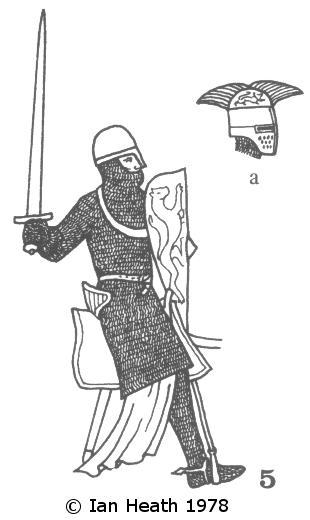
Shop Amazon - Create an Amazon Baby Registry
FRANKISH KNIGHT c.1189
An extract from Armies and Enemies of the Crusades 1096-1291by Ian Heath
[Based on the seal of Richard Coeur-de-Lion]



5. FRANKISH KNIGHT c.1189
This figure is based on the seal of the most famous crusader of them all, King Richard I of England, known to posterity as Richard Coeur de Lion - Richard the Lion-Heart. The seal was probably executed immediately prior to his departure for the Third Crusade.
The sleeves of the hauberk now have mail mittens attached, and in addition separate mail defences (called hosen or chausses) are worn to protect the legs. Chausses had been in use since the mid-11th century but only came into widespread use about a century later; certainly they were standard equipment for wealthier knights by this date, and the author of the Itinerarium Regis Ricardi notes with alarm how Richard went into battle at Jaffa without his chausses.
His helmet is hemispherical rather than conical; a flat-topped variety could also be worn, and 5a, from Richardís second seal of a few years later, shows another type of helmet with a face-guard, just beginning to appear at about this date; note also the early crest. Another early occurrence of a crest is in an incident at the siege of Tyre in 1187, where a knight is recorded with a pair of stagís antlers fixed to his helmet. The shield displays Richardís heraldic device, two rampant lions facing each other, which also appeared on the back of his saddle. Heraldry evolved in about the mid-12th century and, in Outremer, may have been encouraged by the Saracensí use of personal devices.